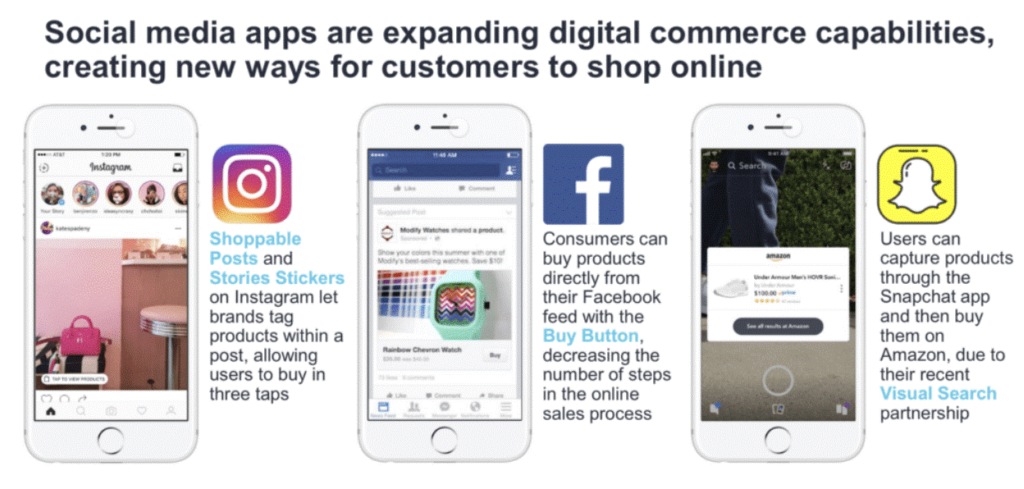
10 Crucial Features to Look for When Buying a CRM System
10 Crucial Features to Look for When Buying a CRM System As you might expect, leading CRM solutions provide a vast array of features, from
Online shopping is more popular than ever before. Online sales are expected to account for 22.3% of total retail sales by 2023. Using social media to engage audiences and build an authentic brand is a significant aspect of ecommerce. However, social media can now also be used as its own ecommerce market: social commerce.
If you’re a frequent user of social media, you’ve likely encountered advertisements that include an embedded link to the product page. Unfortunately, the extra seconds of friction that a customer encounters when being redirected to an ecommerce site can be sufficient to deter captive audiences.
Social commerce enables customers to shop without ever leaving the application. No, they are not being directed to a website or landing page. They are immediately making a purchase from your post in their preferred social media app.
People frequently confuse ecommerce and social commerce because both involve social media marketing. In reality, ecommerce and social commerce are two distinctly distinct sales methods.
Ecommerce is the traditional form of online shopping. It is the process of generating leads and converting customers via online stores. Whether your customers make purchases in an app or on your website, the marketing strategy focuses on driving sales and generating conversions by attracting customers to your website, landing page, or product page.
Social media marketing entails promoting your products, interacting with customers, and driving traffic to your website or landing page, where customers can make a purchase. All marketing and engagement occurs on social media, whereas the purchasing process occurs on the ecommerce website of the retailer.

Social commerce is the ideal combination of ecommerce and social media marketing, involving the direct sale of products on social media. Instead of using social media accounts solely for user engagement, social commerce enables brands to capitalise on their captive audience by integrating shopping capabilities into their posts. Social commerce is currently a $89.4 billion market that is projected to reach $604.5 billion by 2027.
Prior to social commerce, the ecommerce customer journey resembled the following: You were perusing social media when you noticed a t-shirt you wanted. You followed the link to the company’s product page and endured a lengthy checkout procedure that required you to provide personal information to a brand you had just met.
Social commerce places the entire shopping experience on social media platforms: You see a shirt you simply must have, tap on it, and proceed to the in-app checkout. With your preferred payment method, your payment information is automatically entered into the appropriate fields. You click the “buy now” button, and your shirt is shipped!

Several social apps permit businesses to conduct transactions without using external links. Facebook, Instagram, and Pinterest all provide in-app shopping experiences. Increasing numbers of brands are providing customers with simple social commerce shopping experiences whenever possible.
Want to distinguish yourself in the thriving social commerce landscape? Here are proven strategies for increasing social commerce sales:
1. Identify your most popular social channels
To capitalise on social commerce, brands must first determine which social media channels are the most popular with their target audiences. You will waste time creating content for people who aren’t truly interested in your products if you play the numbers game and market your business on every social media channel imaginable.
Concentrate on two or three of your most important social media channels to optimise your social commerce efforts. Ask your marketing department which social networks generate the most revenue and where your content receives the most engagement. Then, conduct a survey to determine where your audience prefers to view your posts.
2. Make sure your posts are shoppable
You must make your posts shoppable in order to participate in social commerce. A shoppable post is a social media post that allows users to tap on a featured product and purchase it in-app. Social commerce makes it easier for audiences to purchase directly from brands through their preferred social media apps. Audiences can become customers in seconds, as opposed to viewing your product in their feed and then navigating to your website to complete the transaction.

By making your posts shoppable, you capitalise on a captive audience. According to Facebook Insights, 81% of consumers conduct product research on Instagram and Facebook before making a purchase. Why not make it simpler for them to purchase when they are already in the shopping mindset?
3. Do not undervalue the influence of social proof
Social proof is the information customers gather from your online presence, user reviews, product ratings, and how people discuss your brand on social media in order to determine the authenticity of your marketing messages. The greater the number of positive reviews your brand has, the more likely it is that your social media audiences will believe your product claims.
If your products do not have many reviews, solicit customer feedback. People unfamiliar with your brand anticipate approximately 100 reviews per product. Reviews reveal what the majority of your customers think of your products and how well you’ve established your brand with a diverse customer base.
4. Adopt social client service
When customers have questions about a specific product while shopping on your ecommerce site, they can navigate to the “contact us” section or use your chatbot to submit an inquiry. What about your social commerce customers, though? Because it would be inconvenient for them to visit your website to ask a question, they will likely anticipate social customer service.
To create a seamless customer service experience, brands must utilise social media messaging to respond to customer inquiries and resolve issues. Depending on the size of your business, you have the option of answering these questions manually or using a chatbot. Thus, the social commerce journey is devoid of external links and additional friction.
5. Join forces with influencers
Influencers already have a following of devoted, trustworthy followers. To expand your reach and enhance the efficacy of your social commerce strategy, you should collaborate with influencers who are popular among your target demographics.
Find relevant social accounts to collaborate with and exploit your shared market niche. Determine which influencers are most relevant to your target audience, then reach out to them to see if they would be interested in reviewing your product in exchange for a free sample.

You can also request that your customers become brand advocates. For instance, request that they share content featuring your products under a specific hashtag, create a rewards programme, or request video testimonials from customers with the chance of featuring them in one of your posts.
6. Lean into personalization
A survey by Accenture found that 91% of customers are more likely to shop with brands that offer personalised experiences. Lean on personalization to attract the attention of key audiences.
For instance, provide customers with product recommendations based on what they’ve purchased from your website in the past. Recommendations are an excellent way to captivate your audience with relevant social media content.
Using a page-level targeting tool, you can configure personalised product recommendations during the checkout process. It triggers specific recommendations based on what customers have purchased in the past. Cross-selling suggestions are a fantastic way to increase cart sizes when page-level targeting is employed.
7. Involve your audience
To provide your audience with a fantastic social commerce experience, you must remember the most crucial aspect: Be social! Engage with your customers in the comments, solicit their feedback, determine what they like and dislike about your products, and provide them with engaging content.
Permit customers to post comments on your shoppable posts so they can ask you product-related questions publicly. This way, you’re also enhancing the customer journey with your brand by creating a FAQ based on user input.
8. Create and test landing pages
Yes, landing pages are external links. And while social commerce necessitates strictly social shopping experiences, audiences who have not yet made a purchase will likely visit your company’s social account to conduct their research.
Including links to your landing pages (for example, in your bio) is an effective method for establishing your online social presence. Additionally, landing pages help customers learn more about your brand and foster brand loyalty within your social media community. (However, do not forget to test and optimise them.)

10 Crucial Features to Look for When Buying a CRM System As you might expect, leading CRM solutions provide a vast array of features, from

7 Ways Telephony and CRM Tools Can Help Your Business Technology has altered how we conduct business. Indeed, technological advancements have improved how companies conduct

This Pixel 4 Can Recognize Life-Changing Diseases Developers from all over the world are attempting to simplify our lives by incorporating numerous new and cutting-edge
